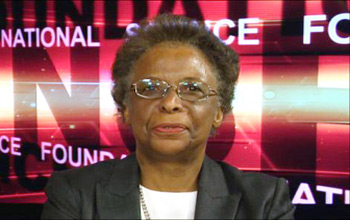News Release 10-081
NSF Launches Website in Support of National Lab Day
Site offers scientists tips for effectively helping teachers, and highlights exemplary K-12 outreach by NSF-funded researchers

Cora Marrett, NSF's acting deputy director, recorded an appeal to participate in National Lab Day
May 11, 2010
This material is available primarily for archival purposes. Telephone numbers or other contact information may be out of date; please see current contact information at media contacts.
The National Science Foundation has launched a Web-based resource for scientists seeking guidance on how to effectively interact with K-12 teachers as part of National Lab Day, a grassroots effort to invigorate science education.
National Lab Day is a volunteer effort designed to form local "communities of support" around science, technology, engineering and mathematics (STEM) teachers and to connect them with STEM professionals who will share their expertise as well as their excitement and passion for their disciplines.
NSF is a partner in National Lab Day, along with other federal science agencies and the National Science Teachers Association, the American Chemical Society, the Bill and Melinda Gates Foundation and the John D. and Catherine T. MacArthur Foundation. National Lab Day is a response to a call to action made by President Obama at the National Academy of Sciences in April, 2009.
The President said during his address, "I want to persuade you to spend time in the classroom, talking and showing young people what it is that your work can mean, and what it means to you ... to think about new and creative ways to engage young people in science and engineering ... encourage young people to be makers of things, not just consumers of things."
Although many National Lab Day 2010 activities will culminate on May 12, there really isn't a single National Lab "Day," according to Janice Cuny, program director in NSF's Computer & Information Science & Engineering directorate's Broadening Participation in Computing program.
In a video message on the site, Cora Marrett, NSF's acting deputy director, said that the hope, instead, is that May 12 will only be the beginning of long-term commitments on the part of those in the wider NSF community to engage in helping our nation's STEM teachers.
In addition to Marrett's recorded message, the NSF Lab Day website at http://www.nsf.gov/news/special_reports/natlabday/ includes an April 14 letter from Arden L. Bement, Jr, NSF director, encouraging NSF-supported researchers, as well as NSF staff, to take up the National Lab Day challenge.
The site also contains a descriptive list of more than 20 existing outreach efforts by NSF-funded researchers to K-12 teachers and students; a series of video clips in which Cuny explains what Lab Day is and how scientists can be become involved and tips from Marti Canipe--a teacher at B'nai Shalom Day School in Greensboro, N.C. and an Albert Einstein Distinguished Educator Fellow in NSF's Office of Polar Programs--on how to be successful and supportive in the K-12 classroom.
There also is a link to the National Lab Day website (http://www.nationallabday.org/), where teachers can post requests related to what they need from researchers and where scientists can register with offers of assistance that match those requests. NSF-funded researchers and agency staff are encouraged to note their affiliation to the agency when they visit the National Lab Day registration page.
-NSF-
Program Contacts
Janice Cuny, NSF, (703) 292-8950, email: jcuny@nsf.gov
Related Websites
NSF National Lab Day Special Report: http://www.nsf.gov/news/special_reports/natlabday/
National Lab Day Website: http://www.nationallabday.org/
National Lab Day registration page: Http://www.nationallabday.org/scientists/new
Text of President Obama's April 2009 speech: http://bit.ly/1qGoRdP
The U.S. National Science Foundation propels the nation forward by advancing fundamental research in all fields of science and engineering. NSF supports research and people by providing facilities, instruments and funding to support their ingenuity and sustain the U.S. as a global leader in research and innovation. With a fiscal year 2023 budget of $9.5 billion, NSF funds reach all 50 states through grants to nearly 2,000 colleges, universities and institutions. Each year, NSF receives more than 40,000 competitive proposals and makes about 11,000 new awards. Those awards include support for cooperative research with industry, Arctic and Antarctic research and operations, and U.S. participation in international scientific efforts.
Connect with us online
NSF website: nsf.gov
NSF News: nsf.gov/news
For News Media: nsf.gov/news/newsroom
Statistics: nsf.gov/statistics/
Awards database: nsf.gov/awardsearch/
Follow us on social
Twitter: twitter.com/NSF
Facebook: facebook.com/US.NSF
Instagram: instagram.com/nsfgov


